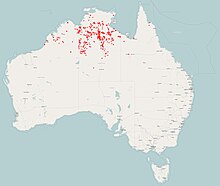| Northern nail-tail wallaby | |
|---|---|

| |
| Scientific classification | |
| Domain: | Eukaryota |
| Kingdom: | Animalia |
| Phylum: | Chordata |
| Class: | Mammalia |
| Infraclass: | Marsupialia |
| Order: | Diprotodontia |
| Family: | Macropodidae |
| Genus: | Onychogalea |
| Species: | O. unguifera
|
| Binomial name | |
| Onychogalea unguifera | |

| |
| The distribution of the northern nail-tail wallaby Data from The Atlas of Living Australia | |
The northern or sandy nail-tail wallaby (Onychogalea unguifera) is a species of macropod found across northern Australia on arid and sparsely wooded plains. The largest species of the genus Onychogalea, it is a solitary and nocturnal herbivorous browser that selects its food from a wide variety of grasses and succulent plant material. Distinguished by a slender and long-limbed form that resembles the typical and well known kangaroos, although their standing height is shorter, around half of one metre, and their weight is less than nine kilograms. As with some medium to large kangaroo species, such as Osphranter rufus, they have an unusual pentapedal motion at slow speeds by stiffening the tail for a fifth limb. When fleeing a disturbance, they hop rapidly with the tail curled back and repeatedly utter the sound "wuluhwuluh". Their exceptionally long tail has a broad fingernail-like protuberance beneath a dark crest of hair at its end, a peculiarity of the genus that is much broader than the other species. The name unguifera, meaning claw, is a reference to this extraordinary attribute, the purpose of which is unknown.
Like the other species of the genus, they retire for the day in a shallow depression, but if disturbed they flee rapidly to find refuge in a hollow tree or thicket. Unlike the rare bridled nail-tail wallaby (O. fraenata), once widespread and currently rare, the northern nail-tail wallaby is not a threatened species.[1] The other member of the genus Onychogalea, the crescent nail-tail wallaby (O. lunata) of the centre and west of Australia, probably became extinct in the mid-20th century.
